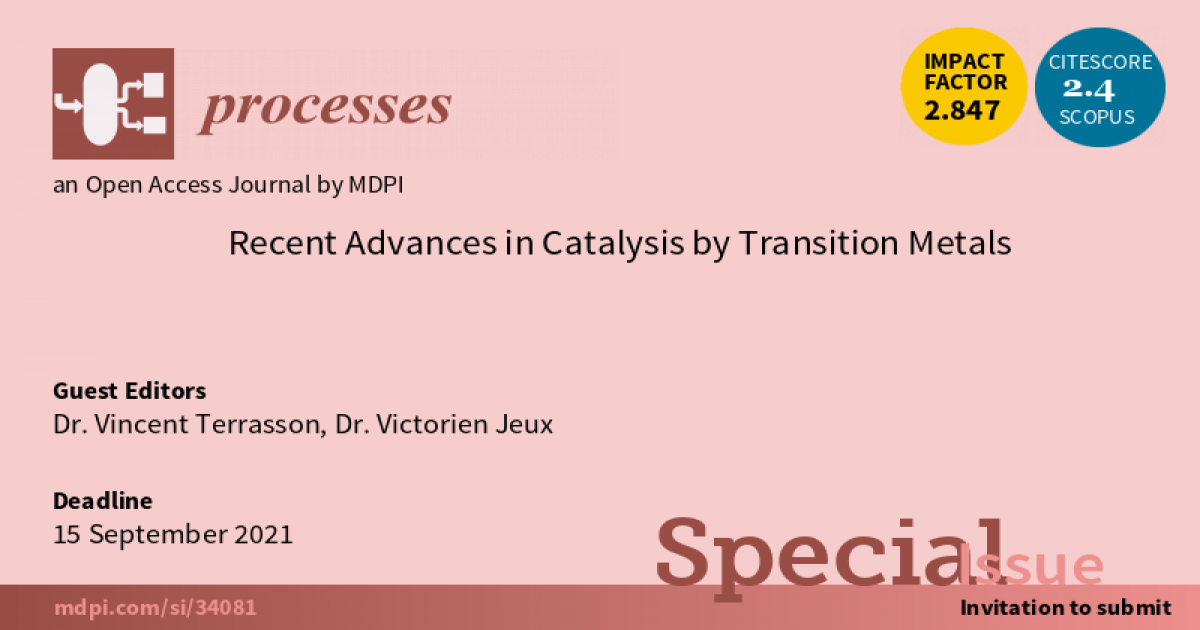Recent Advances in Catalysis by Transition Metals
A special issue of Processes (ISSN 2227-9717). This special issue belongs to the section "Catalysis Enhanced Processes".
Deadline for manuscript submissions: closed (15 September 2021) | Viewed by 15600

Special Issue Editors
Interests: biomass; lignin; green chemistry; organocatalysis; cross-coupling; catalysis; organic synthesis; asymmetric synthesis; nanoparticles; homogeneous catalysis; supported catalysis
Special Issues, Collections and Topics in MDPI journals
Interests: preparation of new materials for organic electronics with eco-friendly syntheses (-conjugated systems, polymers, photovoltaic)
Special Issues, Collections and Topics in MDPI journals
Special Issue Information
Dear Colleagues,
Catalysis is one of the twelve principles of Green Chemistry. At present, nearly 95% of products synthesized by chemical industries are prepared with at least one step using catalysis, and the catalytic systems based on transition metals have found numerous applications in fine chemistry. However, even if the usefulness of catalysis for the synthesis of highly valuable molecules is well known, its development and expansion in industrial processes are still hampered by several obstacles. Indeed, frequent uses of high catalyst loadings combined with the difficulty to recycle the most commonly employed homogeneous catalysts result in an important consumption of noble metals and a potentially high cost for the process. Moreover, reactions catalyzed by heterogeneous catalysts usually suffer from a weak selectivity and the need for harsher conditions. Therefore, the development of new highly efficient and selective catalysts or improvements of the existing catalytic processes are still necessary.
This Special Issue collects original research papers or reviews focused on catalysis by transition metals. This Special Issue aims to cover recent progress and advances in designing new catalysts (with an improved activity or selectivity compared to existing ones), developing catalytic transformations towards valuable molecules or materials (with a reduced number of steps or milder conditions than previously described) or improving catalytic processes (greener conditions, recyclability, etc.)
Topics include but are not limited to:
- Synthesis and characterization of new transition metal complexes with enhanced catalytic properties;
- Investigations on heterogeneous catalysis with transition metals;
- Preparation of transition metal nanoparticles for catalytic transformations;
- Development of new catalytic transformations;
- Use of catalytic processes for the synthesis of important building blocks, valuable molecules or materials;
- Transition metal catalysis as a powerful tool for green chemistry.
Dr. Vincent Terrasson
Dr. Victorien Jeux
Guest Editors
Manuscript Submission Information
Manuscripts should be submitted online at www.mdpi.com by registering and logging in to this website. Once you are registered, click here to go to the submission form. Manuscripts can be submitted until the deadline. All submissions that pass pre-check are peer-reviewed. Accepted papers will be published continuously in the journal (as soon as accepted) and will be listed together on the special issue website. Research articles, review articles as well as short communications are invited. For planned papers, a title and short abstract (about 100 words) can be sent to the Editorial Office for announcement on this website.
Submitted manuscripts should not have been published previously, nor be under consideration for publication elsewhere (except conference proceedings papers). All manuscripts are thoroughly refereed through a single-blind peer-review process. A guide for authors and other relevant information for submission of manuscripts is available on the Instructions for Authors page. Processes is an international peer-reviewed open access monthly journal published by MDPI.
Please visit the Instructions for Authors page before submitting a manuscript. The Article Processing Charge (APC) for publication in this open access journal is 2400 CHF (Swiss Francs). Submitted papers should be well formatted and use good English. Authors may use MDPI's English editing service prior to publication or during author revisions.
Keywords
- catalysts
- transition metals
- metal complexes
- homogeneous catalysis
- nanoparticles
- heterogenous catalysis
- photocatalysis
- green chemistry






